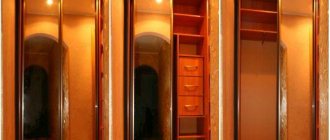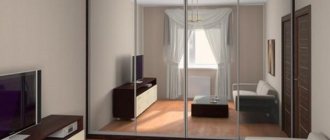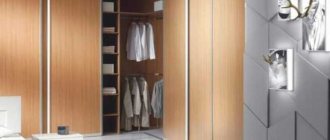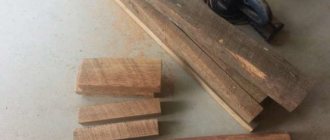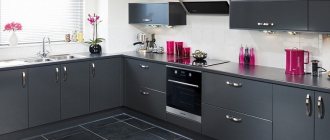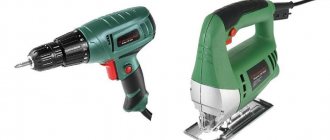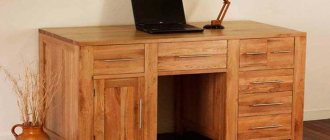Technique
0
653
Share
It's hard to imagine a modern kitchen without an air purifier. Today, several varieties of this household appliance are produced, but flat kitchen hoods have gained particular popularity among consumers.
Flat hood Baumatic TEL 06 W is an excellent choice for the kitchen
- Appearance
- Kinds
- Job
- Choice
Main advantages of the design
Apartment kitchens are small in size and there is not enough space for free movement. The problem is solved by installing the system inside one of the kitchen wall cabinets. An air duct passes through it, flowing smoothly into the ventilation hole on the wall, and it is possible to store things inside the cabinet with the pipe.
Scheme of work
Cabinet hoods for home use have these advantages:
- aesthetic appeal, complementing the design of the kitchen space;
- saving the spatial resource of the kitchen room;
- all pipes of the structure are completely hidden;
- fastening is reliable, practical, convenient;
- the filters are located outside, behind the grease mesh, which makes them easy to change;
- guarantee of system performance quality;
- ease of maintenance of the mechanism;
- complete safety of the presented type of mechanism;
- Possibility of installation above gas stoves and hobs.
When installing, the type of stove is taken into account, because the device should be placed higher above the gas one, and lower above the electric one. The distance from the hob is 60-80 centimeters.
Built-in hood: brief introduction
According to the principle of operation, kitchen hoods are of two types:
- Flow-through. Polluted air is cleaned of soot and grease and removed through the external ventilation system.
- Recirculation. Polluted air is purified through a filter system and returned to the room.
Built-in hoods are of the recirculation type; they are installed in a wall cabinet above the stove. The built-in hood looks quite aesthetically pleasing, as it is completely hidden. The body of the built-in hood has a cubic shape; some models are equipped with a retractable panel to increase the air intake area.
A flow-type hood can be easily mounted in a kitchen cabinet above the stove
The built-in hood is the most compact solution compared to other varieties.
A flat-shaped suspended hood can also be classified as a built-in system of the simplest design. It is installed on a hanging cabinet installed above the stove, in the area of its bottom part. Flat hoods are considered the most budget option with satisfactory qualities in terms of performance. They remove all excess fumes and foreign odors from the kitchen along with other models.
Basic selection tips
A hood built into a cabinet costs twice as much as a conventional kitchen design. This is determined by its structure, quality, and suitability for installation.
Opened
In order for the system to become useful in the kitchen, its selection is carried out according to this principle:
- take accurate measurements of the upper cabinet and hob;
- find a system that matches the parameters in the store and purchase it;
- if it is impossible to select the size, you should order a cabinet for the exhaust system, mount it, install the structure;
- elements of the system must be made into one unit before installation inside the cabinet;
- there are sizes of exhaust structures 45-90 centimeters;
- if the consumer needs silent operation, a corrugated pipe will not suit him.
When a corrugated pipe is purchased to reduce the noise of the system, this structural element is completely leveled. This is done by stretching. The convenience of such a device lies precisely in its flexibility and stability. At the same time, there are additional savings for installation, because No additional kneeling devices are purchased.
The cabinet under the hood is always secured with strong screws. Additionally, the structure is bolted to the adjacent wall. This prevents the kitchen cabinet from falling. It is practical to select rectangular air ducts, connecting the pipes with elbows. These additions are durable and standard on 80% of exhaust systems. The hob should be located under the exhaust structure - the latter is slightly wider than the stove.
Criterias of choice
When choosing a built-in hood, pay attention to the dimensions, power adjustment, noise level, and appearance.
Dimensions
The width of the hood should be greater than the hob . Before purchasing, measure the dimensions of the stove and kitchen facades and select equipment in strict accordance with them.
If the hood is narrow, steam, smoke and grease particles will accumulate on the ceiling and kitchen facades. An unpleasant-smelling coating forms on surfaces. This will ruin the appearance of the kitchen.
Power
Most “built-in hoods” have a power of 200 W. It is recommended to purchase equipment with power control. When food is being cooked in the kitchen for a long time, and oil is splashing in all directions and steam is coming out, set the maximum power.
If you cook porridge or boil water on the stove, the power is reduced. Power regulates the pulling force, the noise level and the amount of energy consumed depend on it.
Performance
This indicator indicates how much air the hood passes through itself within one hour in exhaust mode. The parameter affects the efficiency of the equipment. The standard rate is 400 m³ per hour.
Appearance
Despite the fact that the hood itself is hidden in the furniture, it is recommended to choose models that match the kitchen facades in color and style.
For a light kitchen choose white options, for a dark one - black or metallic.
How to install a hood inside a cabinet yourself
To install a cabinet above the hood, consumers call craftsmen. Brave users undertake to do the installation themselves. The instructions for performing the process in the form give an idea of how to carry out the process step by step.
This establishing moment should be described as follows:
- install a kitchen cabinet according to size - if there is none at all;
- make a hole in the bottom, middle, top shelf that is suitable in size to the parameters of the air duct pipe;
- insert the corrugated pipe inside, making the necessary bends, a regular rectangular one, connecting at the bends with special bends;
- attach a pipe element to the back wall of the cabinet - there are holes intended for this;
- connect the air duct element to the outer head of the structure, bolt it to the bottom of the cabinet;
- install a charcoal and grease filter, install a grill;
- Additionally, use a drill to make a hole inside the back wall of the cabinet so that there is somewhere to thread the cord for the outlet.
- Connect the end of the air duct pipe (cut if necessary) to the ventilation hole in the wall.
After installation, the condition of the moving part is monitored - it should slide freely. Installation of a built-in hood in a cabinet is carried out according to the instructions. Designed for a specific model, taking into account the type of ventilation of the room, the structural features of the cabinet, its size, location.
A non-return valve is installed inside the kitchen hood. Additionally, a clamp purchased at a hardware store is installed, which helps to disassemble the structure at the time of its complete cleaning. High-quality cleaning of the hood with your own hands is carried out using special detergents. Filters are changed every 4-12 months - the period depends on the type, quality, and manufacturer of the kitchen exhaust system.
We recommend watching 2 detailed videos on how to make a cabinet above the hood
So, for a regular (overhead) hood, a simple module is designed equal to its width
Its height is determined in such a way that it would be convenient for the owner of this kitchen to use the hood.
Typically, this technique is located no lower than 650 and no higher than 850 mm (plus or minus 50 mm) from the surface of the slab.
To make it more convenient to remove the corrugation from the module into the ventilation hole, its upper horizon may be shallower in depth than the lower one.
For example, if the bottom one has a depth of 300mm, then the top one is 120mm.
This is done for three reasons:
- The difference in the depth of the horizons (180mm) is quite enough for the free placement of the corrugation, which fits into the “choke” on the wall.
- Saves some material
- It is possible to insert a back wall with a shelf (and this will hide all the “insides” and create additional rigidity).
We will dwell on the last point in more detail.
The fact is that in the usual version (yes, let me remind you that the back wall is usually missing), when you open the door, we get a not entirely aesthetic appearance.
There is emptiness inside, in the lower horizon there is a hole from which a corrugation comes out... It doesn’t look very good.
But if you make a back wall (from the same laminated chipboard) between the horizons and a shelf, then the appearance of the box will become more aesthetic, and you can put something small on the shelf.
So, let's write down the dimensions:
- Height – 500mm
- Width – 600mm
- Depth – 300mm
- Lower horizon – 568 by 300 – 1 piece
- Upper horizon – 568 by 120 – 1 piece
- Side – 500 by 300 – 2 pieces
- Rear wall – 468 by 568 – 1 piece (here you can reduce the height and width by 1 mm for ease of installation).
- Shelf – 568 by 100 – 1 pc.
Well, the facades can be different - two hinged, or one that opens from top to bottom (on elevators).
As you can see, the upper horizon, 120mm deep, not only provides space for the corrugation (at the back), but also the presence of a 100mm shelf:
120-16-100=4 (mm) – the gap from the shelf to the front edge of the side, where 120mm is the depth of the upper horizon, 16mm is the thickness of the rear wall, 100mm is the depth of the shelf.
To fasten the hood, it has special holes in the corners (with threads) into which you need to screw special bolts (which, as a rule, are included in the kit).
But rather than bother with marking the lower horizon for this fastener, it’s easier to make a number of holes in it for 30x4 self-tapping screws, and use them to tighten everything “live.”
The telescopic hood is attached to the box according to a similar scheme, except that the lower horizon is attached “by installation”
The fact is that its built-in part must be inside the module.
It is also attached to its lower horizon, which, in turn, turns out to be raised (to the height of the built-in part).
And the installation of this technology itself is quite simple.
First, the assembled module is installed on the hood.
Then, the lower horizon is installed “in place” (with a pre-made hole for the corrugation), and its actual location is recorded.
Then, at this level, holes are made in the sides of the box, and it is fixed.
All calculations, in this case, are similar to those we considered at the beginning, with the exception of the dimensions of the rear wall.
It will directly depend on the dimensions of the built-in equipment.
Small clarification.
If a façade on lifts (elevators) is planned for the module, then its internal space for the installation of this fittings must be taken into account (this is especially true for gas elevators).
And also, carefully mark the facades for the hinges (if they are hinged).
The last photo shows that the lower loop is always shifted upward, which is due to the design feature.
The small dimensions of the kitchen force us to select compact options for its arrangement, which can be placed in one of the furnishings. Such options, which allow you to significantly save useful meters and centimeters, include a built-in hood. It takes up minimal space and does not affect the interior.
You can handle the installation of built-in exhaust hoods with your own hands if you know all the rules and subtleties of the work. We will tell you how to choose a unit for extracting exhaust air in the kitchen, and we will tell you how to install your purchase correctly.
Is the exhaust system inside the cabinet safe?
The kitchen built-in hood meets domestic and international quality standards. The system adapts to installation inside a cabinet.
The safety parameters of the kitchen room element are proven by these points:
- fastening is carried out to the rear wall, the bottom of the cabinet;
- the bolts are selected strong and long;
- Manufacturers adapt designs for hobs, gas or electric. stove;
- The manufacturer sets the location parameters at a specific height.
Video instructions or user manuals included with the device upon purchase tell you how to install the hood inside the cabinet.
This system meets the required standards, removes food odors, removes steam from the room, operates continuously, and gives signals about the need to replace the filter component. The cost is higher than a regular hood, the quality is comparable to professional hoods.
The exhaust system head remains outside, the air duct, wires, and fastening elements remain inside the cabinet. When using corrugated pipes, the consumer needs to completely level them; this reduces the noise level. A hood smaller than the width of the slab will not perform high-quality work.
Which 60 cm built-in hood for a kitchen cabinet is the best?
Today on the household appliances market you can see a wide range of hoods of different brands. Each model from a well-known manufacturer has its own significant advantages and minor disadvantages.
In order not to make a mistake in choosing quality equipment, you need to study information about well-known manufacturers of kitchen hoods, and then, among the proposed models, choose the most suitable option for a particular case.
Modern manufacturers provide many options in order to choose the optimal model of hood for the kitchen.
Built-in hood Krona
Each new model of Krona kitchen hood testifies to the manufacturer’s commitment to creating improved equipment that is accessible to every customer. Since the country of origin of Krona hoods is Germany, no one will have any doubts about the quality of the products. It is here that the best technical innovations and useful solutions are introduced, and modern, trendy product design is created.
The large assortment of Krona kitchen hoods allows each client to choose the most suitable option that can meet the stated characteristics and will be affordable.
The company specializes in the production of built-in appliances, which include fully built-in and telescopic hoods with compact dimensions. They are ideal for small and medium kitchens.
Kitchen hood “Krona”
Most Kron kitchen hoods are equipped with the Intellect Start system, which is able to detect the intensity of cooking and automatically adjust the mode that allows you to most effectively clean the air. The latest models can operate remotely and are controlled using a remote control.
The built-in hood Krona Camilla 600 mm is especially popular among consumers. This is a telescopic type of device that begins to work when the filter panel is pulled out with a grease filter. The model has a low noise level of up to 55 dB, control is carried out using a push-button switch. The performance of the device, with two motors, reaches 550 cubic meters. m. per hour.
You can buy a Krona hood for 9 thousand rubles. And by adding a couple more thousand, you can buy an easy-to-use and impressive Krona 600 mm hood with a digital display, timer and sensor. While a 60 cm inclined hood for a kitchen with the same performance will cost 14.5 thousand rubles.
Hood "Crown" 60 cm interior
Built-in hood Bosch 60 cm
Another leader in the production of high-quality household appliances is the German company Bosch. The built-in Bosch 60 cm hood, like other household appliances from this manufacturer, will be the key to coziness, comfort and well-being during its operation. It is able to cope with cleaning the most polluted air, which has absorbed the smell of burnt food and a failed culinary experiment.
Bosch kitchen hoods 60 cm, like other models, are equipped with durable motor engines. All components are manufactured in German factories, which does not raise doubts about the long service life of the equipment. All Bosch 60 cm built-in kitchen hoods are created based on basic ergonomic criteria, and therefore have a convenient shape and design to make using the device as easy as possible while cooking.
Bosch gas stove hoods are equipped with an EcoSensor mode, thanks to which the built-in sensor monitors air pollution and automatically selects the required suction mode.
Built-in hood "Bosch"
The average cost of a Bosch telescopic hood with average performance reaches 6 thousand rubles. While you can buy a 60 cm Bosch dome hood for the kitchen with the same performance starting from 9 thousand rubles.
Kitchen hoods Elikor
One of the largest Russian manufacturers of hoods is the Elikor company. She creates products of high European quality with unusual designs that correspond to local preferences and traditions.
It is important to know! Unlike other well-known brands, the Elicor company not only produces hoods painted in different colors, but also decorates them with decorative elements using carvings and gilding.
Kitchen hood “Elikor” 60 cm
Each model is created taking into account the basic principles of ergonomics and has the maximum number of functions that ensure convenient and comfortable operation of the device.
All 60 cm kitchen hoods of this brand are controlled by a push-button switch. The average productivity of the Elicor 60 cm hood is 400 m3/h. The Elikor Integra 60 hood model is used for small or medium-sized kitchens. It operates almost silently, which creates additional comfort. However, low power does not prevent the absorption of the necessary volume of contaminated air that is formed during the most intense cooking process, such as frying.
The Elikor Integra 60 hood can operate in recirculation mode, which does not require connection to the ventilation shaft. You can buy an Elikor hood starting from 2.5 thousand rubles.
Built-in hood "Elikor"
Built-in kitchen hoods 60 cm Gefes
Belarusian Hephaestus equipment is not inferior to European brands in terms of work quality, product functionality, service life and design features. To create hoods, the company uses high-quality materials that are purchased abroad.
Hephaestus hoods are very convenient and easy to operate, equipped with high-quality lighting. Maximum productivity reaches 1000 cubic meters. m. per hour, which is ideal for medium and large kitchens. Despite this, they have an optimal noise level, which does not cause discomfort during operation of the device.
To get a compact and ergonomic device that will provide effective air purification in the kitchen, just buy a 60 cm built-in kitchen hood from a world-famous brand for only 3 thousand rubles. It will be able to operate in recirculation mode and with air exhaust to general ventilation. Control is carried out by a push-button switch, with which you can select one of three speeds of the device.
Built-in hood "Hephaestus"
The price of the Hephaestus hood directly depends on the performance and type of device. The most powerful built-in model with a productivity of 1000 m3/h will cost an average of 10 thousand rubles. While a 60 cm Hephaestus dome hood will cost 12.5 thousand rubles.
Why should you buy a Hansa kitchen hood?
If you need a hood with maximum operating efficiency, but at an inexpensive cost, then you should buy a 60 cm kitchen hood from the German manufacturer Hansa. Thanks to their compact design, all built-in hoods can be easily hidden in the kitchen unit.
To create a number of models, the manufacturer uses high-quality components from well-known European manufacturers, which allows for silent operation of the device.
Kitchen hood “Hansa”
The body of each hood is made exclusively from environmentally friendly materials.
A built-in Hans 60 cm hood with a minimum productivity of 300 m3/hour will cost only 2 thousand rubles. The price of a device with greater productivity will be about 5 thousand rubles.
Helpful advice! To achieve fast and high-quality operation of a device that can work for a long time, you can opt for Hans hood models equipped with two motors.
You should approach the choice of a built-in hood for the kitchen with great responsibility. To do this, you need to study all the design features of this device, read consumer reviews of well-known brands, and ask for advice from professionals who deal with installing hoods every day. Having settled on a specific model, you should definitely find out how to clean and replace the filter, and where it can be purchased. It is necessary to clarify the addresses of service centers and the warranty period of the selected device.
When planning the placement and installation of the hood, it is necessary to take into account the size of the room and the direction of air flow
Additional features of embedded systems
The fume hood functions as a grease trap, steam and odor eliminator. It is a beautiful piece of furniture.
Additional control parameters for expensive models:
- regulation of the brightness level of the built-in backlight;
- assigning voice commands to the system;
- automatic change of operating modes - depends on the intensity of use of the hob;
- setting the time to turn on and off the ventilation system using the timer mode;
- the presence of sensors that respond to the level of contamination of filtration components;
- installation of two filtration elements - performing coarse and fine cleaning at the same time.
The warranty period for high-quality, branded models is 2-3 years - this is a standard parameter. When installing an exhaust system that is installed in a closet, it is better to remove the bottom of the furniture element completely; without this option, you will have to drill a hole of the required size.
Is this type of hood good? The answer is yes, subject to proper selection and installation.
What it looks like in the interior
Built-in appliances look stylish and laconic in any interior. It emphasizes the advantages of the kitchen and hides its shortcomings.
To ensure that the equipment matches the furniture, it is selected according to color and shape. The white hood is universal, it is suitable for any style - loft, Provence, vintage, modern, retro.
Gray and metallic will fit perfectly into modern designs. Many manufacturers (for example, SMEG or Bosch) offer stylized hoods in unusual colors and decorations.
